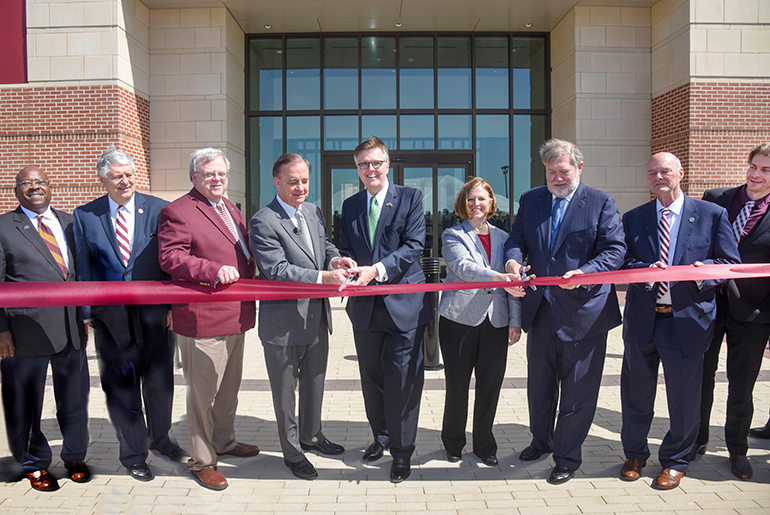
Credited with acquiring the legislative funding needed for The Texas A&M University System’s Center for Infrastructure Renewal (CIR), Texas Lieutenant Governor Dan Patrick was the special guest for the center’s ribbon-cutting ceremony held on the RELLIS Campus April 11. The 138,000-square-foot, multidisciplinary research center boasts state-of-the-art research facilities and laboratories aimed at making infrastructure smarter, more resilient and longer lasting. Ground was broken for the $80 million project 17 months ago.
“At this particular time in history, infrastructure is a part of the national conversation,” Greg Winfree, agency director of the Texas A&M Transportation Institute (TTI), told the crowd gathered for the ceremony. “It’s never been more important to our state and to our country.”
The center is a joint facility operated by TTI and the Texas A&M Engineering Experiment Station (TEES) that will leverage the strengths of numerous engineering professionals to develop research-based solutions to engineering and transportation challenges.
“Imagine roads being paved with new materials that instantly harden so roads reopen immediately afterward,” A&M System Chancellor John Sharp said, highlighting some of the expected products of the center. “New ways to use asphalt that will pay for this place 50 times over, bridges that have sensors that self-report when they weaken and need replacing, and homes and businesses that are flood- and wind-proof. Just imagine what this facility is going to be.”
Prior to the ceremony, Sharp, Patrick, Vice Chancellor and Dean of Engineering and TEES Director M. Katherine Banks, and several other elected officials who had critical roles in the conceptualization, funding, support and construction of the center toured its newly opened laboratories. The CIR is designed to renew every public-critical infrastructure system—from transportation to nuclear reactors to water systems. This is a one-of-a-kind coordinated, cross-disciplinary effort to focus on improving the nation’s infrastructure for the long term.
Sharp introduced Patrick, telling the crowd that the CIR “absolutely would not have happened without him.”
“After walking through here, I know this is an investment that’s going to pay great dividends to the university, other universities, to the country, to the state of Texas,” Patrick said from the podium. “It’s going to make infrastructure more efficient, more affordable and safer for us.”
 Texas Governor Greg Abbott signed a proclamation that was presented to Sharp by Tommy Williams, senior advisor for fiscal affairs for the governor, recognizing the CIR ribbon cutting ceremony.
Texas Governor Greg Abbott signed a proclamation that was presented to Sharp by Tommy Williams, senior advisor for fiscal affairs for the governor, recognizing the CIR ribbon cutting ceremony.
Charles Schwartz, chairman of the A&M System Board of Regents, gave attendees an overview of the new campus.
“A few years ago, RELLIS existed only as an idea in the mind of John Sharp,” Schwartz stated. “In a few short years, we’ve seen an amazing development on these 2,000 acres. CIR will be a place where we’ll deliver the kind of professional workforce development training that we need in this state. We’ll see big things from these laboratories, and the people of the state of Texas will benefit from them.”
Other members of the stage party included: Texas Senator Paul Bettencourt of Houston; Texas Representative John Raney of Bryan/College Station; Texas Representative Paul Workman of Austin; Texas A&M University President Michael Young; Banks; and Zachary Grasley, CIR director.
Top photo pictured left to right: Greg Winfree, TTI Agency Director; Paul Workman, State Representative, District 47; Paul Bettencourt, State Senator, District 7; John Sharp, Texas A&M University System Chancellor; Dan Patrick, Texas Lieutenant Governor; M. Katherine Banks, Vice Chancellor and Dean of Engineering and TEES Agency Director; Charles Schwartz, Chairman, The Texas A&M University System Board of Regents; John Raney, State Representative, District 14; Zachary Grasley, CIR Director. (Photo: TTI)
Video courtesy of the A&M System.